dashboard Acura RL 2000 3.5 Owner's Guide
[x] Cancel search | Manufacturer: ACURA, Model Year: 2000, Model line: RL, Model: Acura RL 2000Pages: 330, PDF Size: 4.53 MB
Page 136 of 330
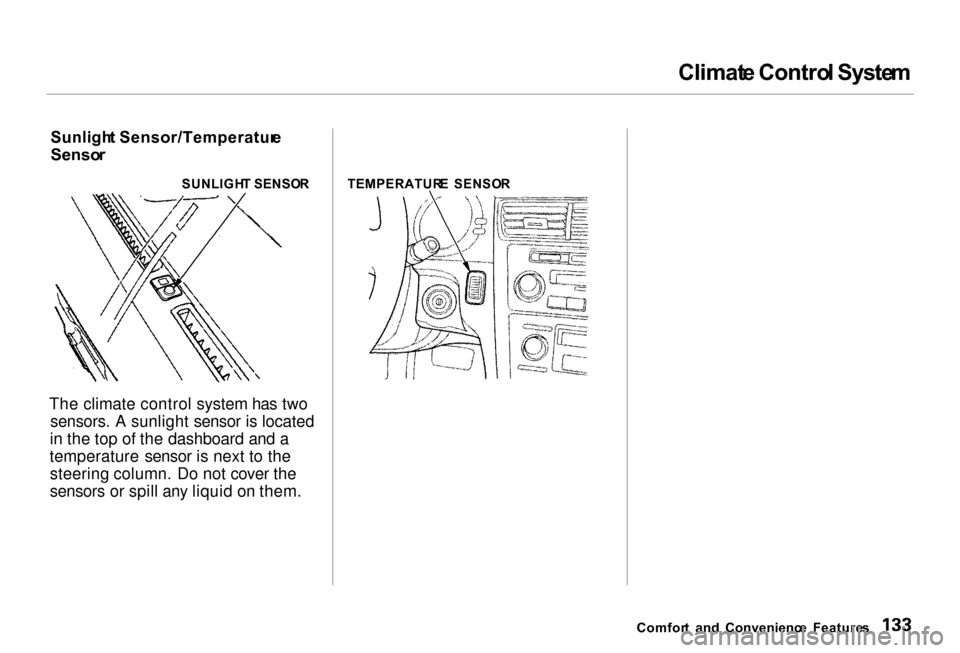
Climat
e Contro l Syste m
Sunligh t Sensor/Temperatur e
Senso r
The climate control system has two sensors. A sunlight sensor is located
in the top of the dashboard and a
temperature sensor is next to the steering column. Do not cover the
sensors or spill any liquid on them.
Comfort an d Convenienc e Feature s
SUNLIGH
T SENSO R TEMPERATUR E SENSO R
Page 166 of 330

Securit
y Syste m
The security system helps to protect your car and valuables from theft.
The horn sounds and a combination of headlights, parking lights, side
marker lights and taillights flashes if
someone attempts to break into your
car or remove the radio. This alarm continues for two minutes, then the
system resets. To reset an alarming
system before the two minutes have
elapsed, unlock either front door
with the key or the remote
transmitter.
The security system sets auto- matically fifteen seconds after you
lock the doors, hood, and trunk. For
the system to activate, you must lock
the doors from the outside with the key, lock tab, door lock switch, or
remote transmitter. The security
system light next to the driver's door
lock starts blinking immediately to show you the system is setting itself. SECURIT
Y SYSTE M LIGH T
Once the security system is set,
opening any door (without using the
key or the remote transmitter), or the hood, will cause it to alarm. It
also alarms if the radio is removed
from the dashboard or the wiring is
cut.
With the system set, you can still
open the trunk with the master key
or the remote transmitter without
triggering the alarm. The alarm will sound if the trunk lock is forced, or
the trunk is opened with the trunk
release button on the driver's door.
The security system will not set if the hood, trunk, or any door is not
fully closed. If the system will not set,check the Door and Brake Lamp
Monitor on the instrument panel (see page 57 ), to see if the doors
and trunk are fully closed. Since it is
not part of the monitor display,
manually check the hood.
Do not attempt to alter this system
or add other devices to it.
Comfor t an d Convenienc e Feature s
Page 171 of 330
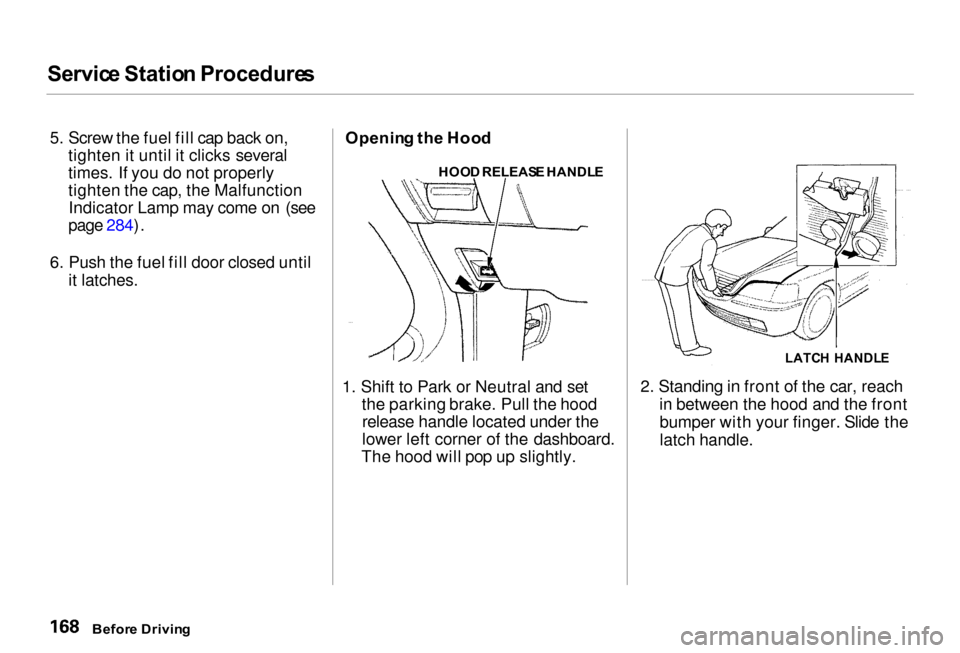
Servic
e Statio n Procedure s
5. Screw the fuel fill cap back on,
tighten it until it clicks several
times. If you do not properly
tighten the cap, the Malfunction Indicator Lamp may come on (see
page 284).
6. Push the fuel fill door closed until
it latches.
Openin g th e Hoo d
1. Shift to Park or Neutral and set
the parking brake. Pull the hood
release handle located under the
lower left corner of the dashboard.
The hood will pop up slightly.
LATC
H HANDL E
2. Standing in front of the car, reach
in between the hood and the front bumper with your finger. Slide the
latch handle.
Befor e Drivin g
HOO
D RELEAS E HANDL E
Page 176 of 330
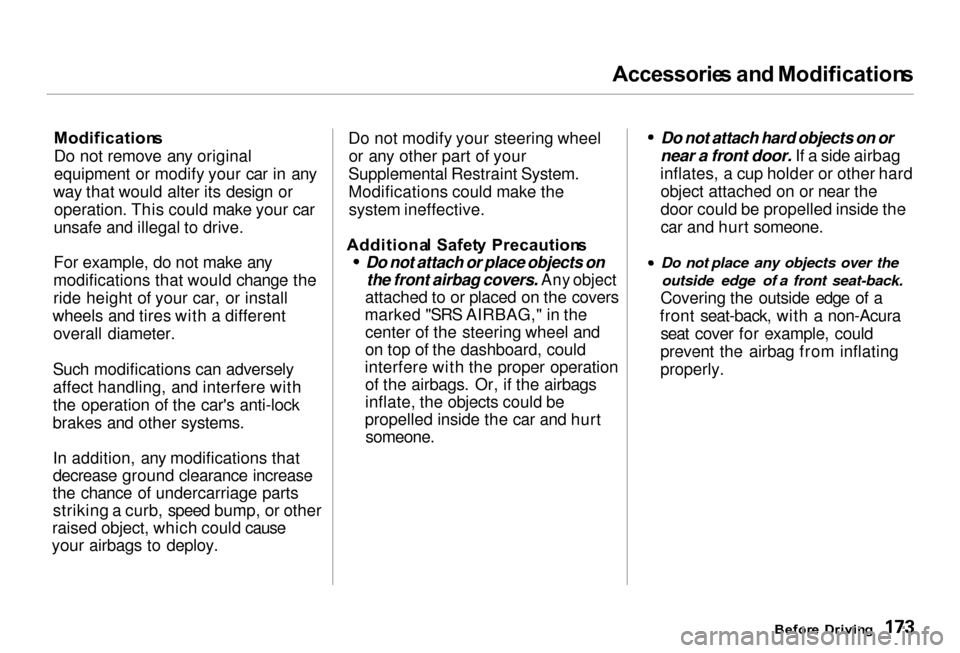
Accessorie
s an d Modification s
Modification s
Do not remove any original
equipment or modify your car in any
way that would alter its design or operation. This could make your car
unsafe and illegal to drive.
For example, do not make any
modifications that would change the
ride height of your car, or install
wheels and tires with a different overall diameter.
Such modifications can adversely
affect handling, and interfere with
the operation of the car's anti-lock
brakes and other systems.
In addition, any modifications that
decrease ground clearance increase
the chance of undercarriage parts striking a curb, speed bump, or other
raised object, which could cause
your airbags to deploy. Do not modify your steering wheel
or any other part of your
Supplemental Restraint System.
Modifications could make the system ineffective.
Additiona l Safet y Precaution s
Do not attach or place objects on
the front airbag covers. Any object
attached to or placed on the covers
marked "SRS AIRBAG," in the center of the steering wheel and
on top of the dashboard, could
interfere with the proper operation of the airbags. Or, if the airbags
inflate, the objects could be
propelled inside the car and hurt
someone.
Do not attach hard objects on or
near a front door. If a side airbag
inflates, a cup holder or other hard object attached on or near the
door could be propelled inside the
car and hurt someone. Do not place any objects over the
outside edge of a front seat-back.
Covering the outside edge of a
front seat-back, with a non-Acura seat cover for example, could
prevent the airbag from inflating
properly.
Before Drivin g
Page 290 of 330
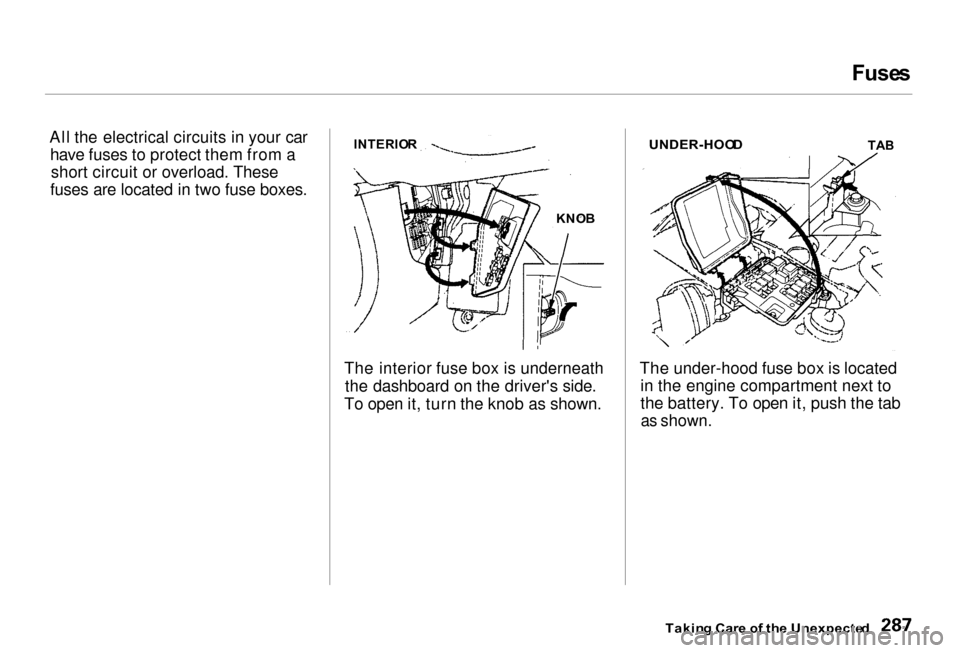
Fuse
s
All the electrical circuits in your car have fuses to protect them from ashort circuit or overload. These
fuses are located in two fuse boxes.
The interior fuse box is underneaththe dashboard on the driver's side.
To open it, turn the knob as shown. The under-hood fuse box is located
in the engine compartment next to
the battery. To open it, push the tab
as shown.
Takin g Car e o f th e Unexpecte d
INTERIO
R
KNOB
UNDER-HOO
D
TAB
Page 299 of 330
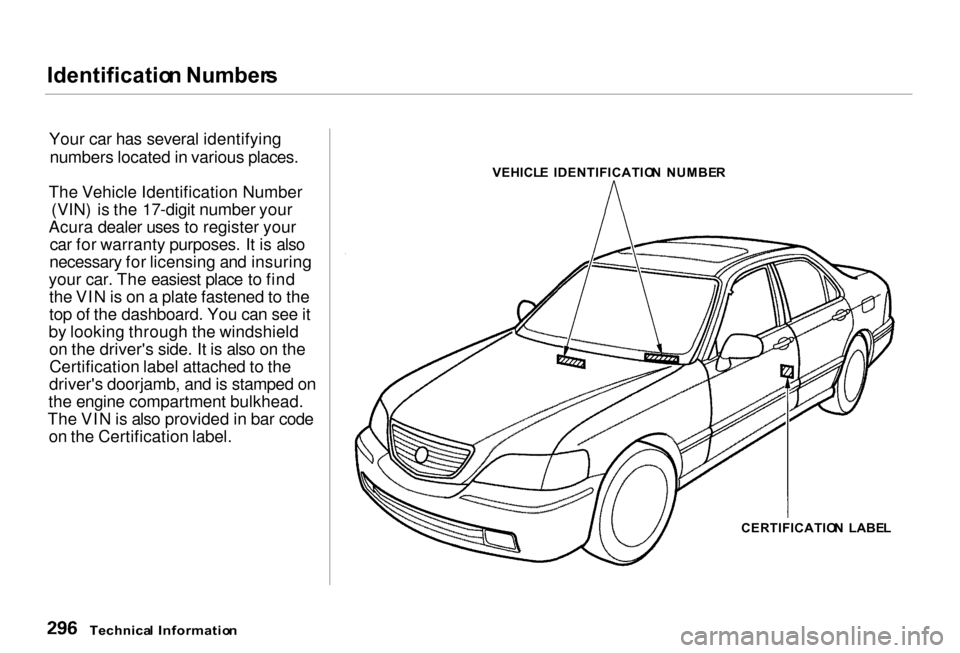
Identificatio
n Number s
Your car has several identifying numbers located in various places.
The Vehicle Identification Number (VIN) is the 17-digit number your
Acura dealer uses to register your car for warranty purposes. It is also
necessary for licensing and insuring
your car. The easiest place to find the VIN is on a plate fastened to the
top of the dashboard. You can see it
by looking through the windshield on the driver's side. It is also on theCertification label attached to the
driver's doorjamb, and is stamped on
the engine compartment bulkhead.
The VIN is also provided in bar code on the Certification label.
Technica l Informatio n
VEHICL
E IDENTIFICATIO N NUMBE R
CERTIFICATIO N LABE L
Page 322 of 330
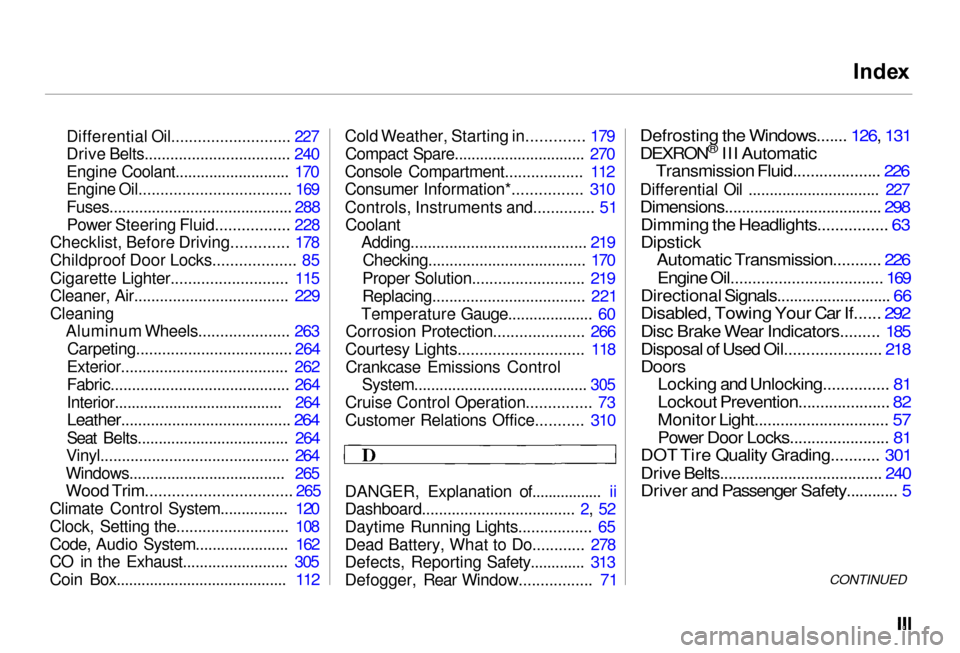
Inde
x
Differential Oil........................... 227
Drive Belts.................................. 240
Engine Coolant........................... 170
Engine Oil................................... 169
Fuses........................................... 288 Power Steering Fluid................. 228
Checklist, Before Driving............. 178
Childproof Door Locks................... 85
Cigarette Lighter........................... 115
Cleaner, Air.................................... 229
Cleaning Aluminum Wheels..................... 263
Carpeting.................................... 264
Exterior....................................... 262
Fabric.......................................... 264
Interior........................................ 264
Leather........................................ 264
Seat Belts.................................... 264
Vinyl............................................ 264
Windows..................................... 265
Wood Trim................................. 265
Climate Control System................ 120
Clock, Setting the.......................... 108
Code, Audio System...................... 162
CO in the Exhaust......................... 305
Coin Box......................................... 112 Cold Weather, Starting in............. 179
Compact Spare............................... 270
Console Compartment.................. 112
Consumer Information*................ 310
Controls, Instruments and.............. 51
Coolant
Adding......................................... 219
Checking..................................... 170
Proper Solution.......................... 219
Replacing.................................... 221
Temperature Gauge.................... 60
Corrosion Protection..................... 266
Courtesy Lights............................. 118 Crankcase Emissions Control System......................................... 305
Cruise Control Operation............... 73
Customer Relations Office........... 310
DANGER, Explanation of................. ii
Dashboard.................................... 2, 52
Daytime Running Lights................. 65
Dead Battery, What to Do............ 278
Defects, Reporting Safety............. 313
Defogger, Rear Window................. 71
Defrosting the Windows....... 126, 131
DEXRON
®
III Automatic
Transmission Fluid.................... 226
Differential Oil ............................... 227
Dimensions..................................... 298
Dimming the Headlights................ 63
Dipstick
Automatic Transmission........... 226
Engine Oil................................... 169
Directional Signals........................... 66
Disabled, Towing Your Car If...... 292
Disc Brake Wear Indicators......... 185
Disposal of Used Oil...................... 218
Doors
Locking and Unlocking............... 81
Lockout Prevention..................... 82
Monitor Light............................... 57
Power Door Locks....................... 81
DOT Tire Quality Grading........... 301
Drive Belts...................................... 240
Driver and Passenger Safety............ 5
CONTINUED